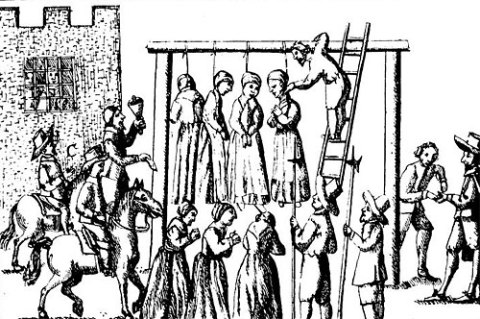
The case of the Newcastle Witches lead to one of the biggest witch trials in England, yet the story is not as well-known as the infamous cases at Berwick and Pendle. This is a tale of a ruthless City Corporation, a coal monopoly, a corrupt witch-finder and how a skeptical Lieutenant with an eye for the ladies saved an accused witch from the gallows-tree.
Newcastle in the Seventeenth Century

The seventeenth century was a time of turmoil, civil war, regicide and religious upheaval; as if this wasn’t enough it was also a superstitious age and an age of dreadful and incurable diseases. All of these factors created a perfect recipe for social and economic uncertainty across England. In such parlous times, people often look for scapegoats….
“In every place and parish, every old woman with a wrinkled face, a scolding tongue, having a rugged coate on her back, a skull-cap on her head, a spindle in her hand, a dog or cat by her side, is not only suspected but pronounced a witch. Every new disease, notable accident, miracle of nature, rarity of art, nay, and strange work or just judgement of God, is by the people accounted for no other but an act or effect of witchcraft.” [1]
Newcastle upon Tyne, in the mid seventeenth century, had been in the thick of things. Burgeoning industrialisation on Tyneside as a whole had created a large class of poor and often disgruntled workers – as many as 40% of households in Newcastle did not have a fireplace. In 1636, the city had been visited by plague and the death toll had been devastating – out of a population of 20,000 people 7,000 died.
In the impending Civil War, Newcastle found itself on the Royalist side and as a hub of the Coal trade was a rich source of funds for the king. As tensions rose in the Kingdom, Charles I decided to introduce (or should that be foist?) the English Prayer Book on Scotland. London merchants saw this as a perfect opportunity to hit out at the King, and hit him where it hurt most (in his pocket) so they encouraged the Scots to capture Newcastle in order to disrupt the highly lucrative coal monopoly. The town was captured in 1640, then again following a siege in 1644 – this time the Scot’s army stayed for two years.

Ralph Gardiner and the coal monopoly
By the end of 1640s, with the Civil War ended, the Corporation of Newcastle was now in the hands of the Puritan’s in place of its former Royal Burgesses. The new Puritan Corporation was no less harsh or money-grubbing than the previous one, and continued to exercise the lucrative monopoly on the coal trade much to the annoyance of one Ralph Gardiner. It is thanks to Gardiner and his book which railed against the Coal monopoly that we have so much information on one of the largest witch trials in England – that of the Newcastle Witches.

Gardiner was an angry man. He was unhappy at the punitive tax on the coal trade exerted by Newcastle, and the attendant risk to ships and men sailing up the perilous river Tyne to pay it. Gardiner felt North Shields was the logical focus for this trade being ideally placed at the mouth of the Tyne rather than several miles in land. To emphasise his case Gardiner also draws on other injustices carried out by the Corporation which further illustrate the arbitrary oppressive nature of the corporation’s rule. As part of his book he looked at the brutal public humiliations visited on citizens of the town – the scold’s bridal being one such punishment. He also took testimonies relating to the notorious witch trials of 1649/1650. One has to respect the bravery of his witnesses in standing up to the witch-finder, one woman who Gardiner spoke too – Elinor Loumsdale – had actually been prosecuted for trying to dissuade witnesses giving evidence against the accused.
Enter the witch-pricker
Fear of witchcraft was rife in Newcastle. The new Puritan Regime fostered this fear with a more fundamental reading of the Bible especially the passage: ‘thou shalt not suffer a witch to live’ (Exodus XX11, V18). In March 1649 the council of Newcastle heard a petition concerning witches. The Puritan council demanded that all witches be tried and sent to Scotland for a witch-finder, or witch-pricker, to assist in rooting out these individuals.
One such man was currently wreaking havoc in Berwick and at 20 shillings a head had rounded up 30 unfortunates whom he accused of witchcraft. It is recorded that some of them confessed to use of harmless magic, whilst others claimed to have been present at Preston (a battle where witchcraft was blamed for the kings defeat). Sensing a profit to be made further south, this unnamed witch-pricker who, according to one local MP ‘professeth himself an artist in that way’ found his way to Newcastle by December 1649.
The newly powerful Puritans of the Corporation encouraged the plague and war ravaged population of the city to vent their frustrations on their neighbours, and they heralded the arrival of the witch-pricker very publicly. The Magistrate’s bellman went about the town announcing that anyone with a complaint against a witch should denounce them, the accused would be brought to the town hall and tried. It seems that many Novocastrians embraced the opportunity to settle old scores and soon 30 people had been brought before the magistrates and their witch-pricker.

Methods used by witch-finders and witch-prickers were quite brutal. Although torture was not legal in England, the accused would often be deprived of sleep or walked for hours until they confessed. They were also subject to public humiliation, being stripped and searched for witch marks which were then ‘pricked’ by the witch-finder. If no blood flowed then they were guilty of witchcraft. It was not unusual for witch-finders to employ retractable bodkins to prick their victims thereby ensuring a guilty verdict – and their fee.
Of the 30 unfortunate women accused at Newcastle, 27 were found guilty, two were declared innocent…but it was the final woman who caused some controversy.

It seems that this final accused was not the usual warty old crone of stereotype, but a quite handsome and well-presented young woman. The woman had been ‘pricked’ by the witch-finder and had not bled thus condemning her to be hanged.
Lieutenant Col Hobson, had witnessed the degrading spectacle. The witch-finder had pulled up the woman’s clothes thereby exposing her, much to her horror. He then appeared to pricked her thigh just as he let her skirts fall about her – thus obscuring the actual ‘pricking’. When questioned as to whether she felt anything, the woman admitted she had not – at this point the witch-finder theatrically reached up her skirts and pulled out his bodkin. She was condemned by her own words. Hobson, who was a Baptist not a Puritan, and was also an ex-military surgeon seems to have suspected either sleight of hand on the part of the witch-finder or simple shock on the part of the woman, objected. May be the fact that she was quite attractive also spurred the gentleman into action –
“The said reputed Witch-finder acquainted Lieutenant Colonel Hobson that he knew women, whether they were Witches or no by their looks, and when the said person was searching of a personable, and good-like woman, the said Colonel replied and said, ‘Surely this woman is none, and need not be tried’..”[2]
Hobson had cunningly tried to employ the witch-finders own argument against him, however the chilling response from the witch-finder was: –
“..but the Scotch-man said she was, for the Town said she was, and therefore he would try her;”[3]
The power of gossip and calumny was all that was required to bring about a successful accusation of witchcraft and clearly young and attractive women could be just as vulnerable to slander as the more obvious targets: old crones. However in this case Hobson insisted that the process was repeated in a more decent manner, this time the woman bled and was thereby acquitted.
Nevertheless, despite Hobson’s intervention, of the remaining accused 14 women and one man were hanged on the Town Moor in August 1650. Their remains were buried in unmarked graves in St Andrew’s Church Newcastle.
The roll call of victims of the one of the largest witch trials in England, was listed by Gardner:
Matthew Bulmer
Eliz. Anderson
Jane Hunter
Mary Pots
Elianor Rogerson
Margaret Muffet
Margaret Maddison
Eliz Brown
Jane Copeland
Ann Watson
Elianor Henderson
Elizabeth Dobson
Katherine Coultor

Karma catches up with the Witch-pricker
Too often these sinister individuals seem to escape justice, however, in this case, the witch-pricker himself met a sticky end. Heading into the remote reaches of Northumberland in order to pick up more fat fees for his vile trade, the witch-pricker found himself arrested by J.P. Henry Ogle. Escaping into Scotland, Gardner says that he was later hanged after confessing to causing the deaths of 220 English and Scottish women. While Gardner does not go so far as to question the judgment or the execution, considering them ‘ordinary’, he shows considerable sympathy towards the women, writing that “These poor souls never confessed anything, but pleaded innocence [..]”. Gardner attacks the legality of the methods used, in particular the sending out to “another nation, for a mercenary person, to try women for witches”. In his view the over-reaching magistrates of Newcastle were just a culpable for the deaths of those innocent women and man as the sadistic witch pricker.
Have the Newcastle witches resurfaced after 350 years?

In 2008, the Newcastle Chronicle reported that teeth, ribs and skull bones had been recovered during renovations to St Andrew’s Churchyard. The bones were believed to be those of the Newcastle Witches finally uncovered after being flung in an unmarked pit following their execution. It was claimed that the bones could be cursed as a workman is said to have come up in blisters and boils following handling the bones….it seems that the even after 350 years very little has changed and people are still willing to attribute strange powers to witches….

Notes
1. John Gaule, 1646, ‘Select cases of conscience touching witches and witchcraft’
2 & 3. Ralph Gardiner’s England’s grievance discovered, in relation to the coal-trade(1655).
4. Image source: https://the1642goodwyfe.wordpress.com/2012/09/26/stripping-whipping-and-pumping/
Sources
Armstrong, Pamela, 1990, Dark Tales of Old Newcastle, Bridge Studios
Bath, Jo, 2002, Dancing with the Devil and other True Tales of Northern Witchcraft, Newcastle City Council
http://www.chroniclelive.co.uk/news/north-east-news/bones-find-casts-spell-workers-1465557
Unattributed, 1989, More Ghosts and Legends of Northumbria, Coquet Editions
http://roy25booth.blogspot.co.uk/2010/02/newcastle-witch-pricker-1649-and-other.html
http://newsfromthespiritworld.com/2012/10/01/witches-wonderful-news-from-the-north-by-dr-jo-bath/
http://www2.newcastle.gov.uk/collections.nsf/display?readform&id=EEC2032B0AFCE516802574270030652B
http://en.wikipedia.org/wiki/Hostmen_of_Newcastle_upon_Tyne





Leave a Reply to Author Ingrid HallCancel reply